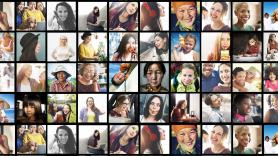Debate
3. Panel discussion: towards participative, personalized medicine
In a session open to the public, representatives from patients’ associations, the media, bioethics and oncology, as well as individual patients, debated the current and future states of medicine, its problems, strengths and weaknesses. Most of the debate focused on the doctor-patient relationship and access to information.
“The first oncologist I saw was a good doctor, I’m not saying he wasn’t,” explained Laura Sancho, Catalan actress diagnosed with breast cancer in 2008, “but he hardly looked at me, and gave me monosyllabic answers to many of my questions. The people who really helped me were the nurses.” Sancho was diagnosed after undergoing some tests to try to get pregnant, something she had to give up on: the increased estrogen levels that come with pregnancy increase the risk of relapsing.
“That wasn’t my case,” explained Rosa Gasa, IDIBAPS Barcelona researcher and breast cancer patient. “Surely, being a researcher, communication is better, but I felt it was very open.”
“One of the most common concerns is communication,” highlighted Clara Rosàs, head of the Catalan Federation of Organizations Against Cancer (FECEC). “We know some do a very good job, but that isn’t always the case.”
Joan Brunet, medical oncologist at the Catalan Institute of Oncology (ICO), said, “When I was studying for my degree, there wasn’t any sort of training in this regard, but now they have included it and you can see the improvement in recent years.” In addition to this, better communication does not take much more time: some studies show that “generating empathy doesn’t add more than a minute or two to visit times.”
“In my opinion, we’re still in a client-like doctor-patient relationship, more suitable to providing services than based on trust. However, things have improved a lot in terms of recognizing that patients are an active part of the process and want to make decisions,” said professor of Moral Philosophy Victoria Camps. “Part of the problem is surely that there isn’t enough time to develop the relationship.”
“The part about participation is true,” recognized Brunet. “But there are also people who turn it down, who don’t want it, and there are times over the course of the disease when doctors have to be more like executives.”
Another key aspect is access to information, mainly on the Internet. Sancho admitted to having spent “hours at the computer. I would look for cases similar to mine and I found loads of nonsense.” For science communicator Pere Estupinyà, “It’s definitely getting worse. On one hand, there’s very good information. Those who complain there isn’t, aren’t looking for it. But the problem is that there’s also a lot of bad information that reaches us via social media without any sort of filter. I think we should design a strategy to rank information sites, to have a benchmark for credibility.” In reality, “when people ask me how to improve science communication, I think what we have to do is eliminate the worst of it.”



